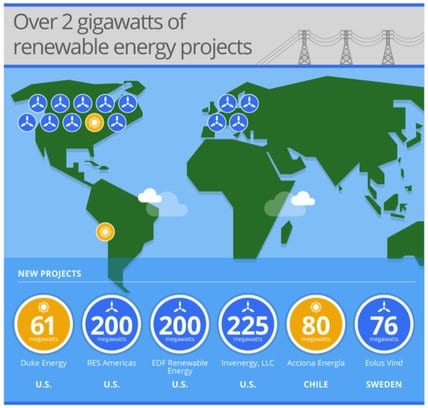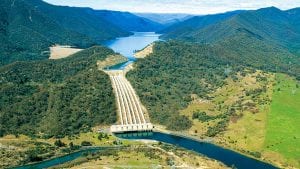Google has made a big deal of its desires to be powered by 100% renewable energy, and in a recent blog post, the company has explained exactly what it means by that goal.
Gary Demasi, Google Director of Data Center Energy & Location Strategy, took to the Google Green Blog this week to explain exactly what Google means when it says it wants to be 100% “powered by renewables”:
“Fundamentally we mean this: Google purchases, on an annual basis, the same volume (MWh) of renewable energy as the volume of MWh of energy that we consume for our operations.”
This isn’t necessarily a ground-breaking explanation, but Demasi goes on to “unpack what this means” by digging deeper into the actual mechanics of Google’s plans.
Demasi actually breaks down the reality of purchasing renewable power relatively well, explaining how there is no way to tell if “the energy from wind farm X is going to supply data center Y.”
Furthermore, Demasi explains why Google can’t simply go off-grid entirely: Not only is it not economic or practical sense for large data center facilities, but renewable energy projects are most-often developed “miles away” from where Google’s data centers currently reside.
There is of course the intermittency issue, as well, which for a data center intent on providing guaranteed 100% up-time would prove utterly useless.

Avoiding intermittency problems is one of the reasons Google relies on purchasing renewable electricity and using electricity provided through the grid.
“For example,” Demasi explains, “our Iowa utility, MidAmerican Energy, has a portfolio of energy generation that is comprised of 40% wind and takes advantage of a large regional network to manage any variability in its system or in an individual wind resource.
Similarly, in Europe, the energy provider for our Finland data center purchases renewable energy in Sweden and uses the Nordpool regional electricity grid to manage variability and deliver us consistent 24×7 power.”
So Google strives to adhere to three criteria when purchasing renewable energy: additionality; bundled physical energy and its “renewable certification”; and proximity.
One can see some of these criteria at work in recent purchases made by Google, including the massive 842 MW renewable energy purchase which included investments in projects in the US, Sweden, and Chile.

Google may need to readdress some of its figures, however, in the wake of a recent study which found data centers use 30% more coal than previously estimated.
“Our team of data scientists analysed the North American electric grid, improving the accuracy of carbon reporting by a factor of 80,” said Ory Zik, Lux Research Vice President of Analytics and the team leader of Lux’s energy benchmarking. “The results show that many sites are far more reliant on coal than reported – notably, they include many large data centers.”
“For example, we found that Google underestimates its dependence on coal in four out of seven data centers, in particular at its Berkeley County, S.C. location.”

The whole blog post is worth a read for anyone interested in the intricacies of a company like Google aiming towards 100% renewable energy.










